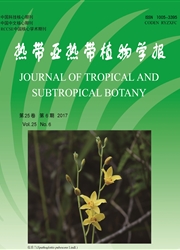

 中文摘要:
中文摘要:
以离体水仙(Narcissus tazetta var.chinensis)花茎切段为材料,通过外源吲哚-3-乙酸(Indole-3-acetic acid,IAA)和赤霉素A3(GA3)处理,结合内源激素分析,研究了这两种激素对水仙花茎切段伸长的影响,以及它们之间的相互作用.结果表明:外源50 μmol/L IAA和30 μmol/L GA3均能促进花茎切段的伸长,其中IAA的促进作用大于GA3.200μmol/L生长素运输抑制剂2,3,5-三碘苯甲酸(2,3,5-Triiodobenzoic acid,TIBA)和65 μmol/L赤霉素合成抑制剂烯效唑(Uniconazole,S-3307)均显著抑制花茎切段的伸长.外源50μmol/LIAA处理明显增加内源GA1+3的含量,是对照的3.40倍;外源30 μm0l/L GA3处理对内源IAA含量影响不明显,说明IAA对维持花茎切段内源活性GA水平起重要作用,IAA和活性GA共同发挥调控花茎切段伸长的作用.
 英文摘要:
英文摘要:
The pedicel segments from Narcissus tazetta var. chinensis were treated with IAA and GA3 for 48 hours, and the length of the segment elongation was determined. The interactions between the two hormones were also discussed. Both 50 μmol/L IAA and 30 μmol/L GA3 were found to promote the elongation of pedicel segments. Moreover, IAA performed more effectively than GA3. Both 2,3,5-triiodobenzoic acid (TIBA) (an IAA polar transport inhibitor) at 200 μmol/L and uniconazole (S-3307) (a gibberellin biosynthesis inhibitor) at 65 μmol/L significantly inhibited the elongation of pedicel segments. Following the 50 μmol/L IAA treatment GA1+3 content in the segments increased 3.4-fold as much as that in the control, whereas IAA content in the segments treated with 30 μmol/L GA3 was slightly varied. It is suggested that IAA plays an important role in maintaining the level of active GA in pedicels and regulates the elongation of the pedicel segments together with GA.
 同期刊论文项目
同期刊论文项目
 同项目期刊论文
同项目期刊论文
 期刊信息
期刊信息
